Workplace Communication: Teamwork & Communication Models Assessment
VerifiedAdded on 2023/06/15
|10
|2637
|302
Report
AI Summary
This report provides an assessment of teamwork and communication in the workplace, focusing on various communication models and basic communication skills. It begins by introducing the importance of effective communication for business success and outlines different communication models, including Aristotle's model, the Osgood-Schramm model, and Berlo's S-M-C-R model, detailing their advantages and disadvantages in a workplace setting. The report further discusses essential communication skills such as clarity, empathy, sincerity, eye contact, posture, speed, volume, pitch, and tone, emphasizing their role in fostering effective workplace communication. It also presents an example of poor workplace communication, suggesting ways to enhance business communication using the discussed models. The report concludes by highlighting the significance of clear and transparent communication for organizational growth and success.
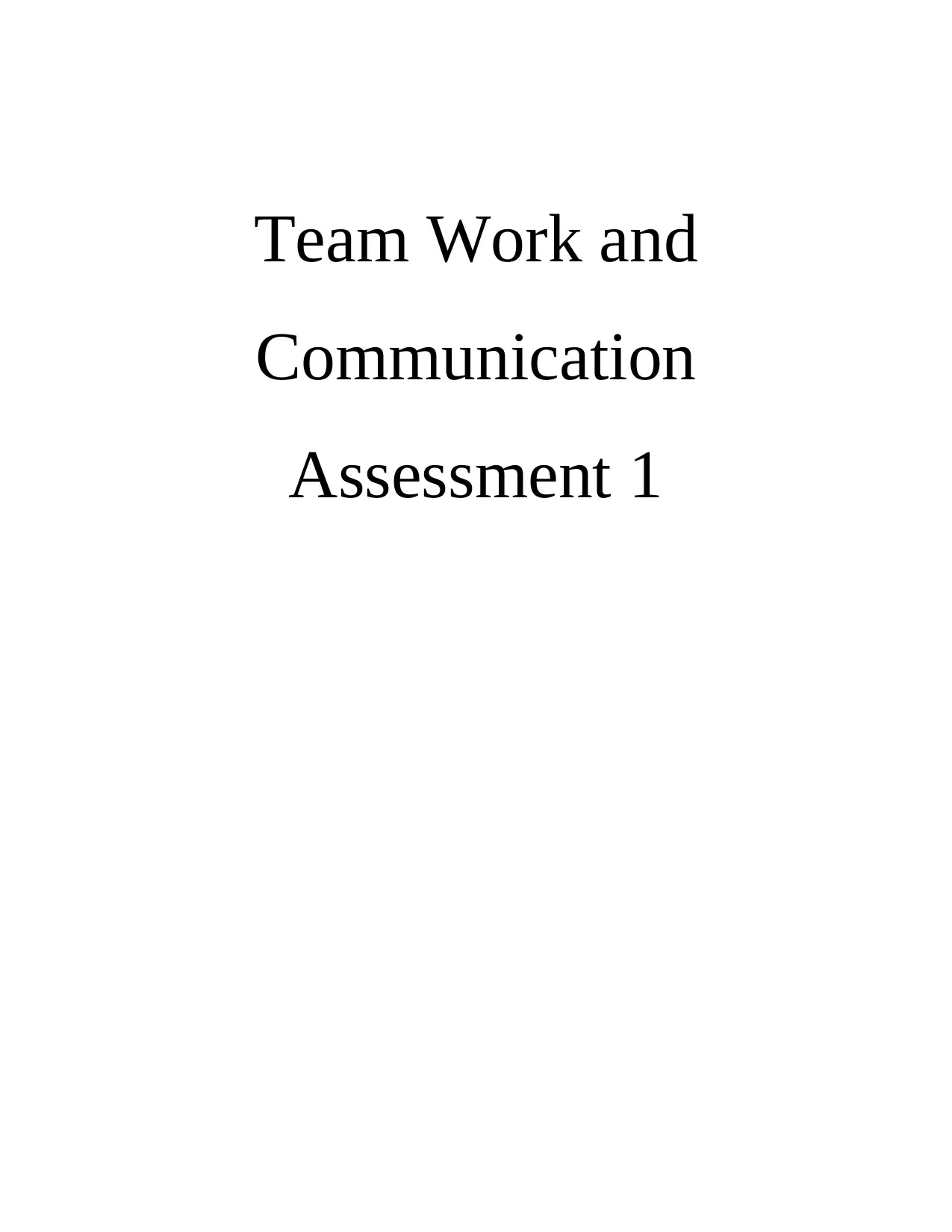
Team Work and
Communication
Assessment 1
Communication
Assessment 1
Paraphrase This Document
Need a fresh take? Get an instant paraphrase of this document with our AI Paraphraser
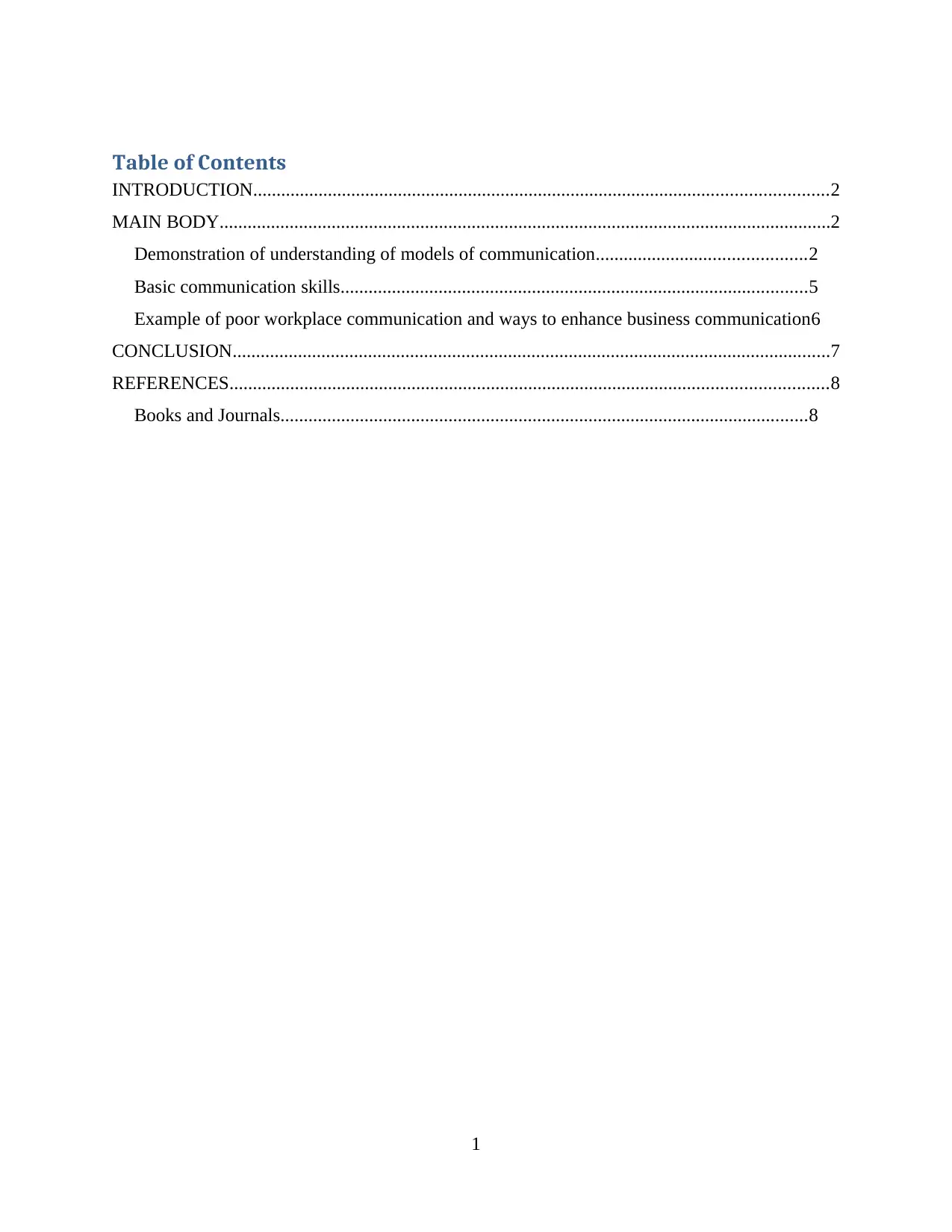
Table of Contents
INTRODUCTION...........................................................................................................................2
MAIN BODY...................................................................................................................................2
Demonstration of understanding of models of communication.............................................2
Basic communication skills....................................................................................................5
Example of poor workplace communication and ways to enhance business communication6
CONCLUSION................................................................................................................................7
REFERENCES................................................................................................................................8
Books and Journals.................................................................................................................8
1
INTRODUCTION...........................................................................................................................2
MAIN BODY...................................................................................................................................2
Demonstration of understanding of models of communication.............................................2
Basic communication skills....................................................................................................5
Example of poor workplace communication and ways to enhance business communication6
CONCLUSION................................................................................................................................7
REFERENCES................................................................................................................................8
Books and Journals.................................................................................................................8
1
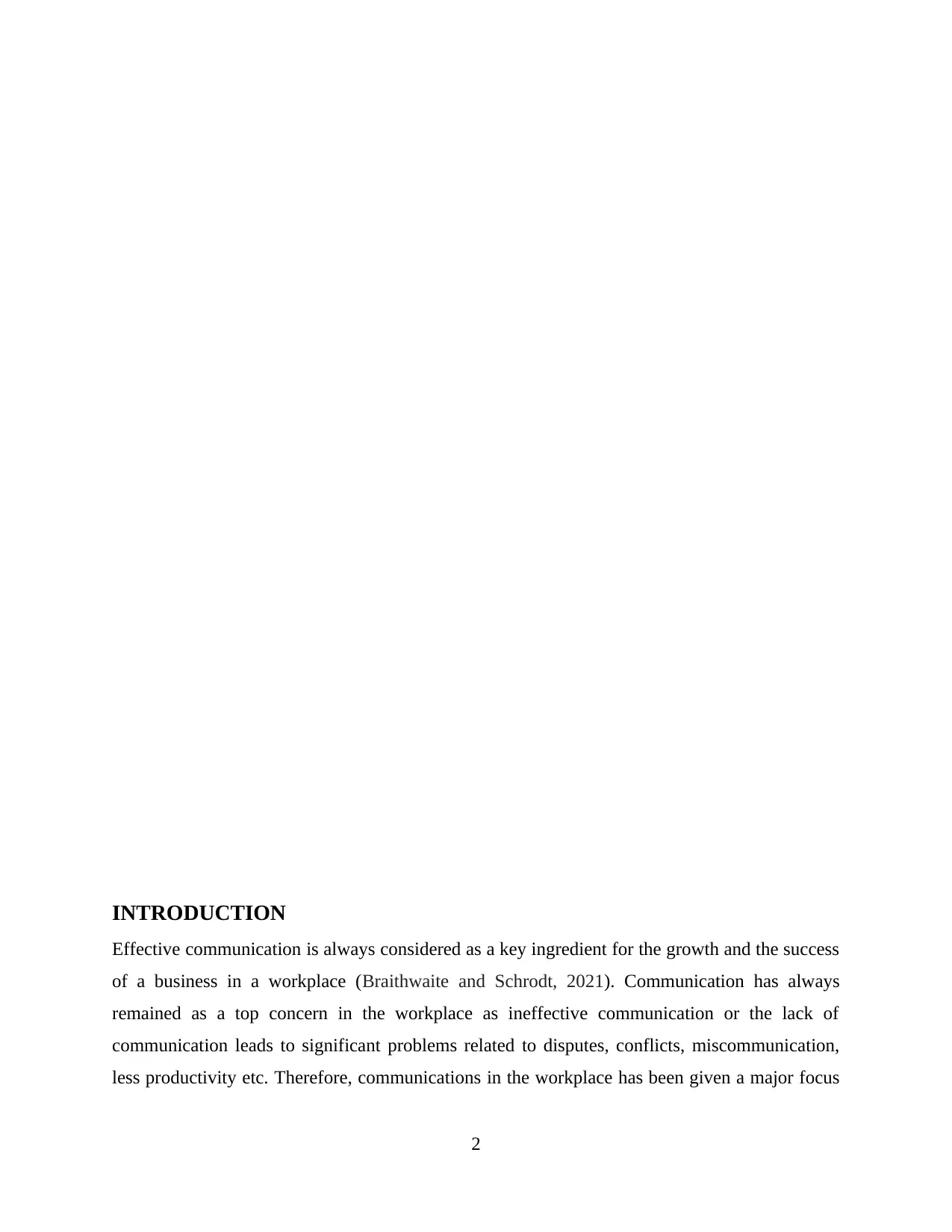
INTRODUCTION
Effective communication is always considered as a key ingredient for the growth and the success
of a business in a workplace (Braithwaite and Schrodt, 2021). Communication has always
remained as a top concern in the workplace as ineffective communication or the lack of
communication leads to significant problems related to disputes, conflicts, miscommunication,
less productivity etc. Therefore, communications in the workplace has been given a major focus
2
Effective communication is always considered as a key ingredient for the growth and the success
of a business in a workplace (Braithwaite and Schrodt, 2021). Communication has always
remained as a top concern in the workplace as ineffective communication or the lack of
communication leads to significant problems related to disputes, conflicts, miscommunication,
less productivity etc. Therefore, communications in the workplace has been given a major focus
2
⊘ This is a preview!⊘
Do you want full access?
Subscribe today to unlock all pages.

Trusted by 1+ million students worldwide
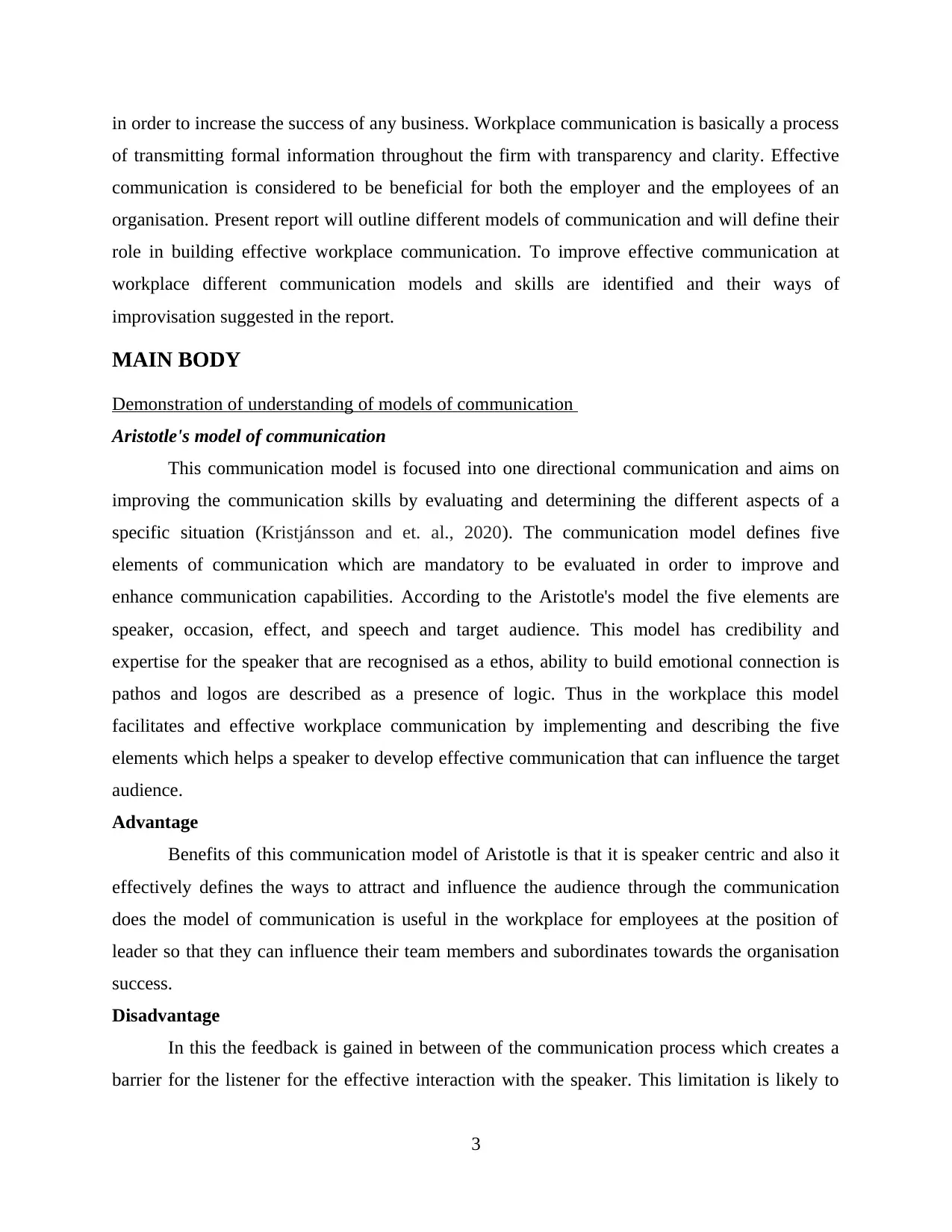
in order to increase the success of any business. Workplace communication is basically a process
of transmitting formal information throughout the firm with transparency and clarity. Effective
communication is considered to be beneficial for both the employer and the employees of an
organisation. Present report will outline different models of communication and will define their
role in building effective workplace communication. To improve effective communication at
workplace different communication models and skills are identified and their ways of
improvisation suggested in the report.
MAIN BODY
Demonstration of understanding of models of communication
Aristotle's model of communication
This communication model is focused into one directional communication and aims on
improving the communication skills by evaluating and determining the different aspects of a
specific situation (Kristjánsson and et. al., 2020). The communication model defines five
elements of communication which are mandatory to be evaluated in order to improve and
enhance communication capabilities. According to the Aristotle's model the five elements are
speaker, occasion, effect, and speech and target audience. This model has credibility and
expertise for the speaker that are recognised as a ethos, ability to build emotional connection is
pathos and logos are described as a presence of logic. Thus in the workplace this model
facilitates and effective workplace communication by implementing and describing the five
elements which helps a speaker to develop effective communication that can influence the target
audience.
Advantage
Benefits of this communication model of Aristotle is that it is speaker centric and also it
effectively defines the ways to attract and influence the audience through the communication
does the model of communication is useful in the workplace for employees at the position of
leader so that they can influence their team members and subordinates towards the organisation
success.
Disadvantage
In this the feedback is gained in between of the communication process which creates a
barrier for the listener for the effective interaction with the speaker. This limitation is likely to
3
of transmitting formal information throughout the firm with transparency and clarity. Effective
communication is considered to be beneficial for both the employer and the employees of an
organisation. Present report will outline different models of communication and will define their
role in building effective workplace communication. To improve effective communication at
workplace different communication models and skills are identified and their ways of
improvisation suggested in the report.
MAIN BODY
Demonstration of understanding of models of communication
Aristotle's model of communication
This communication model is focused into one directional communication and aims on
improving the communication skills by evaluating and determining the different aspects of a
specific situation (Kristjánsson and et. al., 2020). The communication model defines five
elements of communication which are mandatory to be evaluated in order to improve and
enhance communication capabilities. According to the Aristotle's model the five elements are
speaker, occasion, effect, and speech and target audience. This model has credibility and
expertise for the speaker that are recognised as a ethos, ability to build emotional connection is
pathos and logos are described as a presence of logic. Thus in the workplace this model
facilitates and effective workplace communication by implementing and describing the five
elements which helps a speaker to develop effective communication that can influence the target
audience.
Advantage
Benefits of this communication model of Aristotle is that it is speaker centric and also it
effectively defines the ways to attract and influence the audience through the communication
does the model of communication is useful in the workplace for employees at the position of
leader so that they can influence their team members and subordinates towards the organisation
success.
Disadvantage
In this the feedback is gained in between of the communication process which creates a
barrier for the listener for the effective interaction with the speaker. This limitation is likely to
3
Paraphrase This Document
Need a fresh take? Get an instant paraphrase of this document with our AI Paraphraser
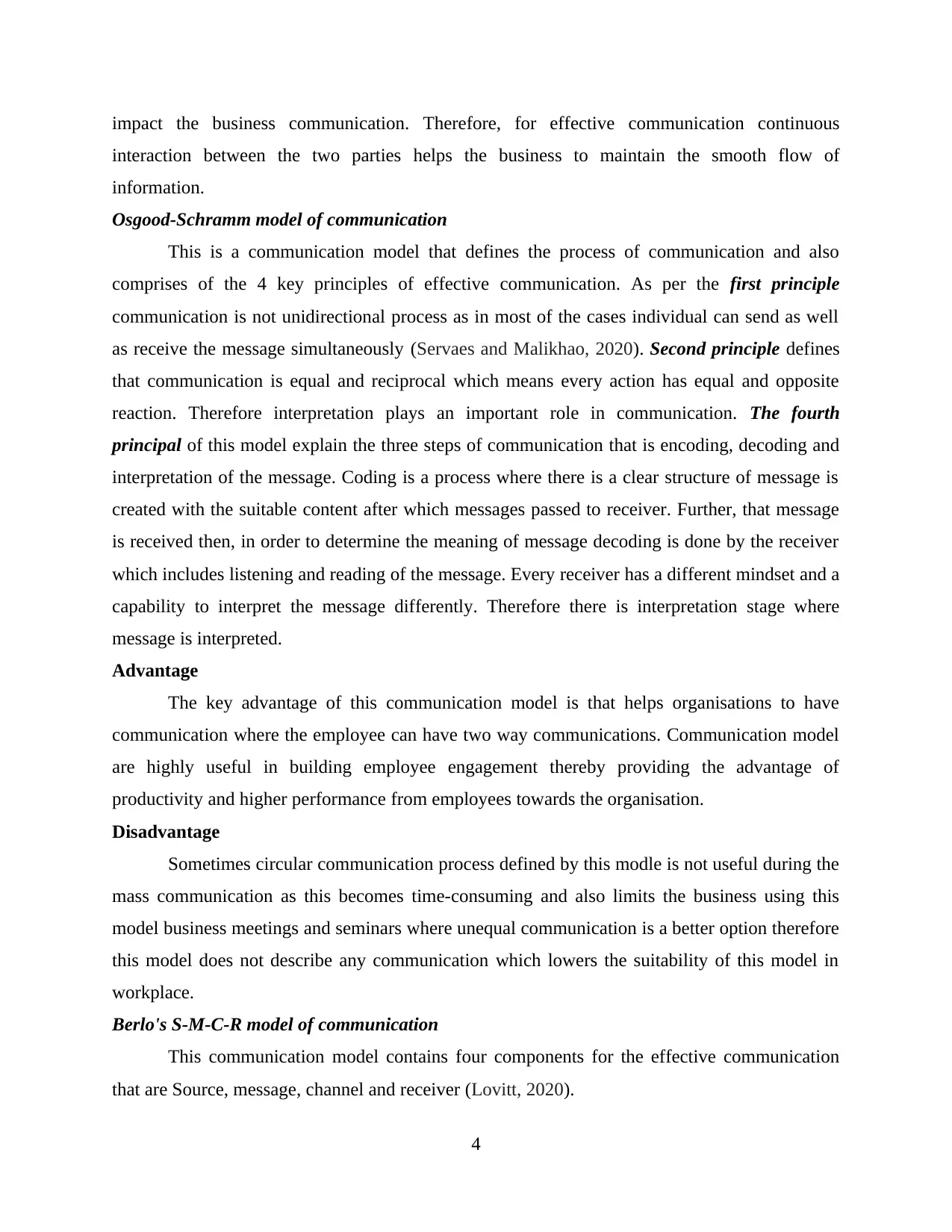
impact the business communication. Therefore, for effective communication continuous
interaction between the two parties helps the business to maintain the smooth flow of
information.
Osgood-Schramm model of communication
This is a communication model that defines the process of communication and also
comprises of the 4 key principles of effective communication. As per the first principle
communication is not unidirectional process as in most of the cases individual can send as well
as receive the message simultaneously (Servaes and Malikhao, 2020). Second principle defines
that communication is equal and reciprocal which means every action has equal and opposite
reaction. Therefore interpretation plays an important role in communication. The fourth
principal of this model explain the three steps of communication that is encoding, decoding and
interpretation of the message. Coding is a process where there is a clear structure of message is
created with the suitable content after which messages passed to receiver. Further, that message
is received then, in order to determine the meaning of message decoding is done by the receiver
which includes listening and reading of the message. Every receiver has a different mindset and a
capability to interpret the message differently. Therefore there is interpretation stage where
message is interpreted.
Advantage
The key advantage of this communication model is that helps organisations to have
communication where the employee can have two way communications. Communication model
are highly useful in building employee engagement thereby providing the advantage of
productivity and higher performance from employees towards the organisation.
Disadvantage
Sometimes circular communication process defined by this modle is not useful during the
mass communication as this becomes time-consuming and also limits the business using this
model business meetings and seminars where unequal communication is a better option therefore
this model does not describe any communication which lowers the suitability of this model in
workplace.
Berlo's S-M-C-R model of communication
This communication model contains four components for the effective communication
that are Source, message, channel and receiver (Lovitt, 2020).
4
interaction between the two parties helps the business to maintain the smooth flow of
information.
Osgood-Schramm model of communication
This is a communication model that defines the process of communication and also
comprises of the 4 key principles of effective communication. As per the first principle
communication is not unidirectional process as in most of the cases individual can send as well
as receive the message simultaneously (Servaes and Malikhao, 2020). Second principle defines
that communication is equal and reciprocal which means every action has equal and opposite
reaction. Therefore interpretation plays an important role in communication. The fourth
principal of this model explain the three steps of communication that is encoding, decoding and
interpretation of the message. Coding is a process where there is a clear structure of message is
created with the suitable content after which messages passed to receiver. Further, that message
is received then, in order to determine the meaning of message decoding is done by the receiver
which includes listening and reading of the message. Every receiver has a different mindset and a
capability to interpret the message differently. Therefore there is interpretation stage where
message is interpreted.
Advantage
The key advantage of this communication model is that helps organisations to have
communication where the employee can have two way communications. Communication model
are highly useful in building employee engagement thereby providing the advantage of
productivity and higher performance from employees towards the organisation.
Disadvantage
Sometimes circular communication process defined by this modle is not useful during the
mass communication as this becomes time-consuming and also limits the business using this
model business meetings and seminars where unequal communication is a better option therefore
this model does not describe any communication which lowers the suitability of this model in
workplace.
Berlo's S-M-C-R model of communication
This communication model contains four components for the effective communication
that are Source, message, channel and receiver (Lovitt, 2020).
4
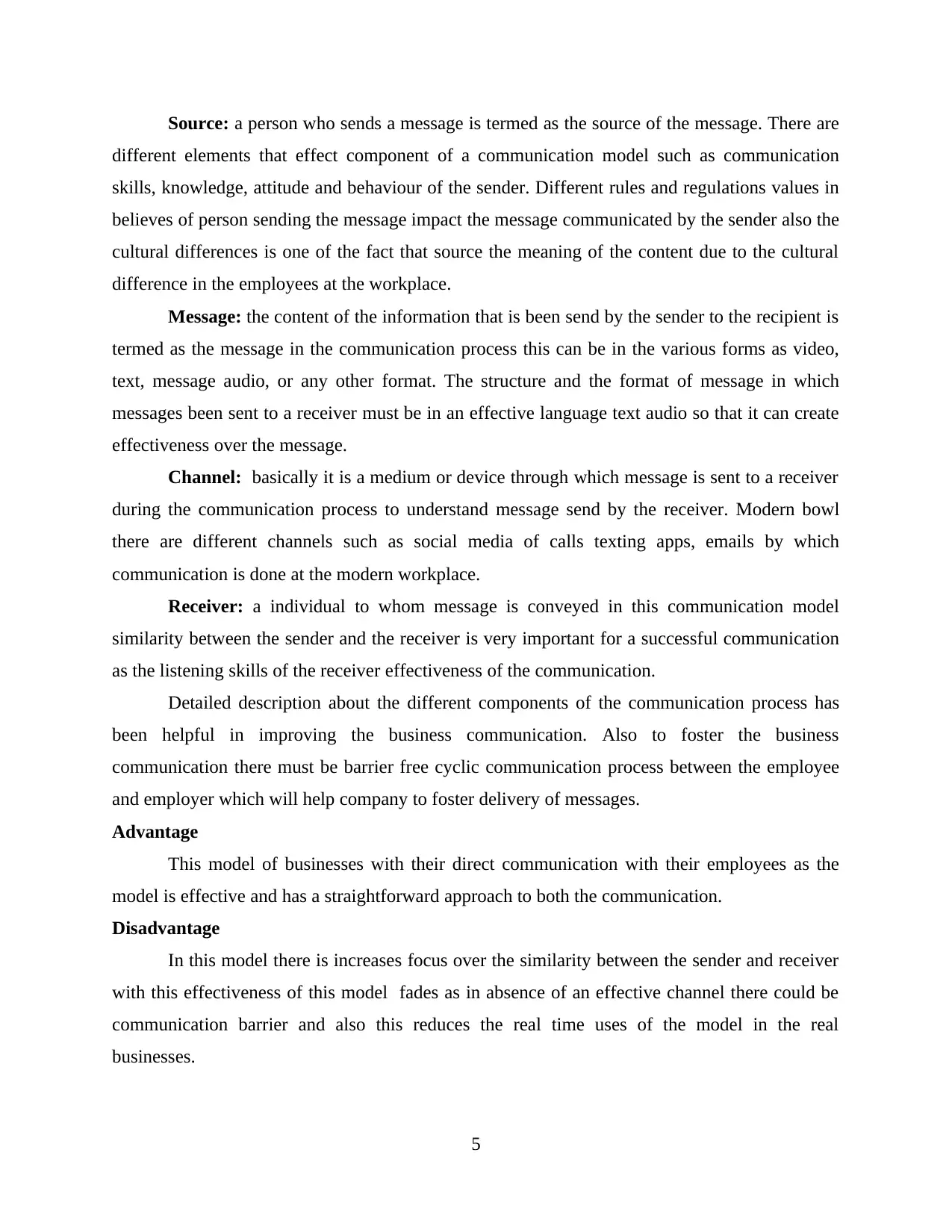
Source: a person who sends a message is termed as the source of the message. There are
different elements that effect component of a communication model such as communication
skills, knowledge, attitude and behaviour of the sender. Different rules and regulations values in
believes of person sending the message impact the message communicated by the sender also the
cultural differences is one of the fact that source the meaning of the content due to the cultural
difference in the employees at the workplace.
Message: the content of the information that is been send by the sender to the recipient is
termed as the message in the communication process this can be in the various forms as video,
text, message audio, or any other format. The structure and the format of message in which
messages been sent to a receiver must be in an effective language text audio so that it can create
effectiveness over the message.
Channel: basically it is a medium or device through which message is sent to a receiver
during the communication process to understand message send by the receiver. Modern bowl
there are different channels such as social media of calls texting apps, emails by which
communication is done at the modern workplace.
Receiver: a individual to whom message is conveyed in this communication model
similarity between the sender and the receiver is very important for a successful communication
as the listening skills of the receiver effectiveness of the communication.
Detailed description about the different components of the communication process has
been helpful in improving the business communication. Also to foster the business
communication there must be barrier free cyclic communication process between the employee
and employer which will help company to foster delivery of messages.
Advantage
This model of businesses with their direct communication with their employees as the
model is effective and has a straightforward approach to both the communication.
Disadvantage
In this model there is increases focus over the similarity between the sender and receiver
with this effectiveness of this model fades as in absence of an effective channel there could be
communication barrier and also this reduces the real time uses of the model in the real
businesses.
5
different elements that effect component of a communication model such as communication
skills, knowledge, attitude and behaviour of the sender. Different rules and regulations values in
believes of person sending the message impact the message communicated by the sender also the
cultural differences is one of the fact that source the meaning of the content due to the cultural
difference in the employees at the workplace.
Message: the content of the information that is been send by the sender to the recipient is
termed as the message in the communication process this can be in the various forms as video,
text, message audio, or any other format. The structure and the format of message in which
messages been sent to a receiver must be in an effective language text audio so that it can create
effectiveness over the message.
Channel: basically it is a medium or device through which message is sent to a receiver
during the communication process to understand message send by the receiver. Modern bowl
there are different channels such as social media of calls texting apps, emails by which
communication is done at the modern workplace.
Receiver: a individual to whom message is conveyed in this communication model
similarity between the sender and the receiver is very important for a successful communication
as the listening skills of the receiver effectiveness of the communication.
Detailed description about the different components of the communication process has
been helpful in improving the business communication. Also to foster the business
communication there must be barrier free cyclic communication process between the employee
and employer which will help company to foster delivery of messages.
Advantage
This model of businesses with their direct communication with their employees as the
model is effective and has a straightforward approach to both the communication.
Disadvantage
In this model there is increases focus over the similarity between the sender and receiver
with this effectiveness of this model fades as in absence of an effective channel there could be
communication barrier and also this reduces the real time uses of the model in the real
businesses.
5
⊘ This is a preview!⊘
Do you want full access?
Subscribe today to unlock all pages.

Trusted by 1+ million students worldwide
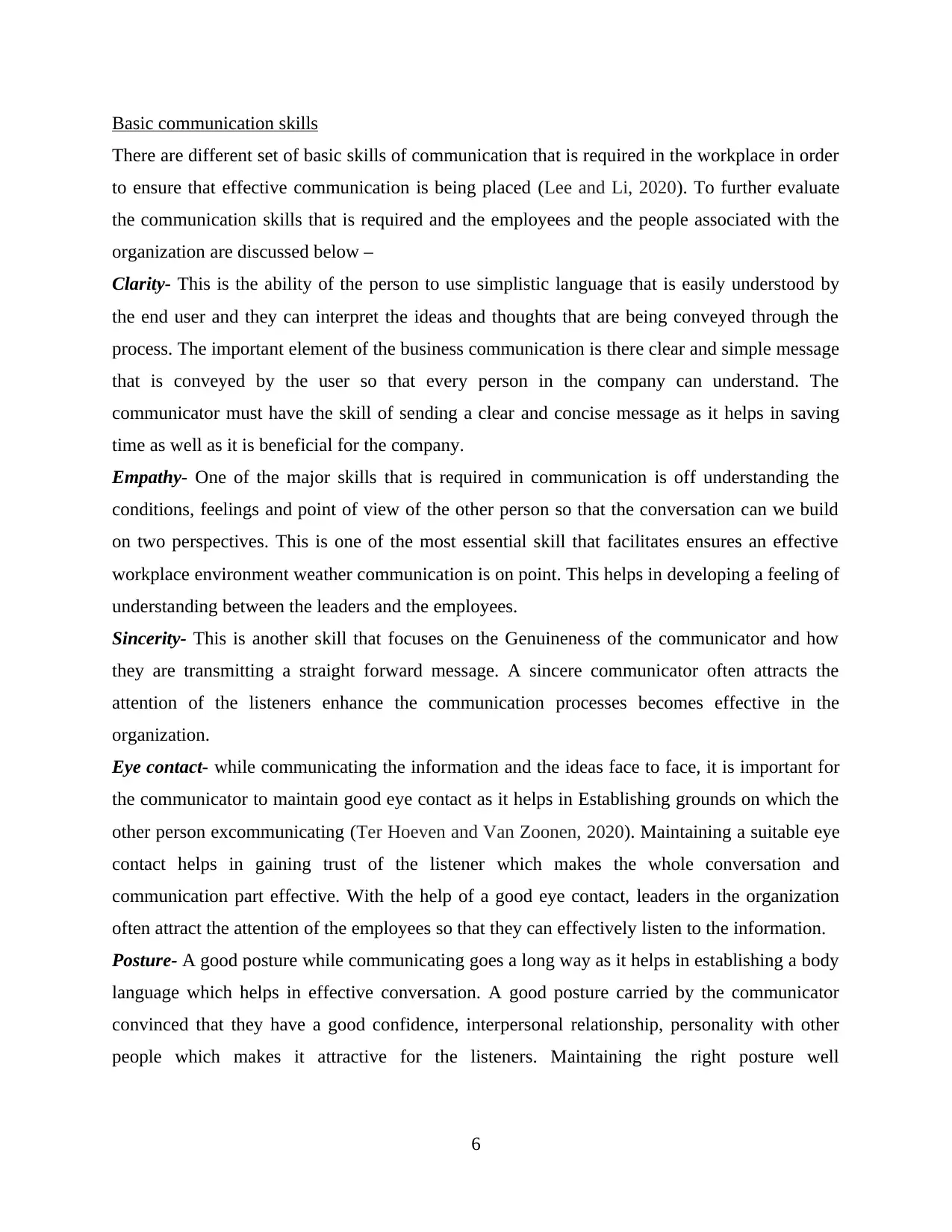
Basic communication skills
There are different set of basic skills of communication that is required in the workplace in order
to ensure that effective communication is being placed (Lee and Li, 2020). To further evaluate
the communication skills that is required and the employees and the people associated with the
organization are discussed below –
Clarity- This is the ability of the person to use simplistic language that is easily understood by
the end user and they can interpret the ideas and thoughts that are being conveyed through the
process. The important element of the business communication is there clear and simple message
that is conveyed by the user so that every person in the company can understand. The
communicator must have the skill of sending a clear and concise message as it helps in saving
time as well as it is beneficial for the company.
Empathy- One of the major skills that is required in communication is off understanding the
conditions, feelings and point of view of the other person so that the conversation can we build
on two perspectives. This is one of the most essential skill that facilitates ensures an effective
workplace environment weather communication is on point. This helps in developing a feeling of
understanding between the leaders and the employees.
Sincerity- This is another skill that focuses on the Genuineness of the communicator and how
they are transmitting a straight forward message. A sincere communicator often attracts the
attention of the listeners enhance the communication processes becomes effective in the
organization.
Eye contact- while communicating the information and the ideas face to face, it is important for
the communicator to maintain good eye contact as it helps in Establishing grounds on which the
other person excommunicating (Ter Hoeven and Van Zoonen, 2020). Maintaining a suitable eye
contact helps in gaining trust of the listener which makes the whole conversation and
communication part effective. With the help of a good eye contact, leaders in the organization
often attract the attention of the employees so that they can effectively listen to the information.
Posture- A good posture while communicating goes a long way as it helps in establishing a body
language which helps in effective conversation. A good posture carried by the communicator
convinced that they have a good confidence, interpersonal relationship, personality with other
people which makes it attractive for the listeners. Maintaining the right posture well
6
There are different set of basic skills of communication that is required in the workplace in order
to ensure that effective communication is being placed (Lee and Li, 2020). To further evaluate
the communication skills that is required and the employees and the people associated with the
organization are discussed below –
Clarity- This is the ability of the person to use simplistic language that is easily understood by
the end user and they can interpret the ideas and thoughts that are being conveyed through the
process. The important element of the business communication is there clear and simple message
that is conveyed by the user so that every person in the company can understand. The
communicator must have the skill of sending a clear and concise message as it helps in saving
time as well as it is beneficial for the company.
Empathy- One of the major skills that is required in communication is off understanding the
conditions, feelings and point of view of the other person so that the conversation can we build
on two perspectives. This is one of the most essential skill that facilitates ensures an effective
workplace environment weather communication is on point. This helps in developing a feeling of
understanding between the leaders and the employees.
Sincerity- This is another skill that focuses on the Genuineness of the communicator and how
they are transmitting a straight forward message. A sincere communicator often attracts the
attention of the listeners enhance the communication processes becomes effective in the
organization.
Eye contact- while communicating the information and the ideas face to face, it is important for
the communicator to maintain good eye contact as it helps in Establishing grounds on which the
other person excommunicating (Ter Hoeven and Van Zoonen, 2020). Maintaining a suitable eye
contact helps in gaining trust of the listener which makes the whole conversation and
communication part effective. With the help of a good eye contact, leaders in the organization
often attract the attention of the employees so that they can effectively listen to the information.
Posture- A good posture while communicating goes a long way as it helps in establishing a body
language which helps in effective conversation. A good posture carried by the communicator
convinced that they have a good confidence, interpersonal relationship, personality with other
people which makes it attractive for the listeners. Maintaining the right posture well
6
Paraphrase This Document
Need a fresh take? Get an instant paraphrase of this document with our AI Paraphraser
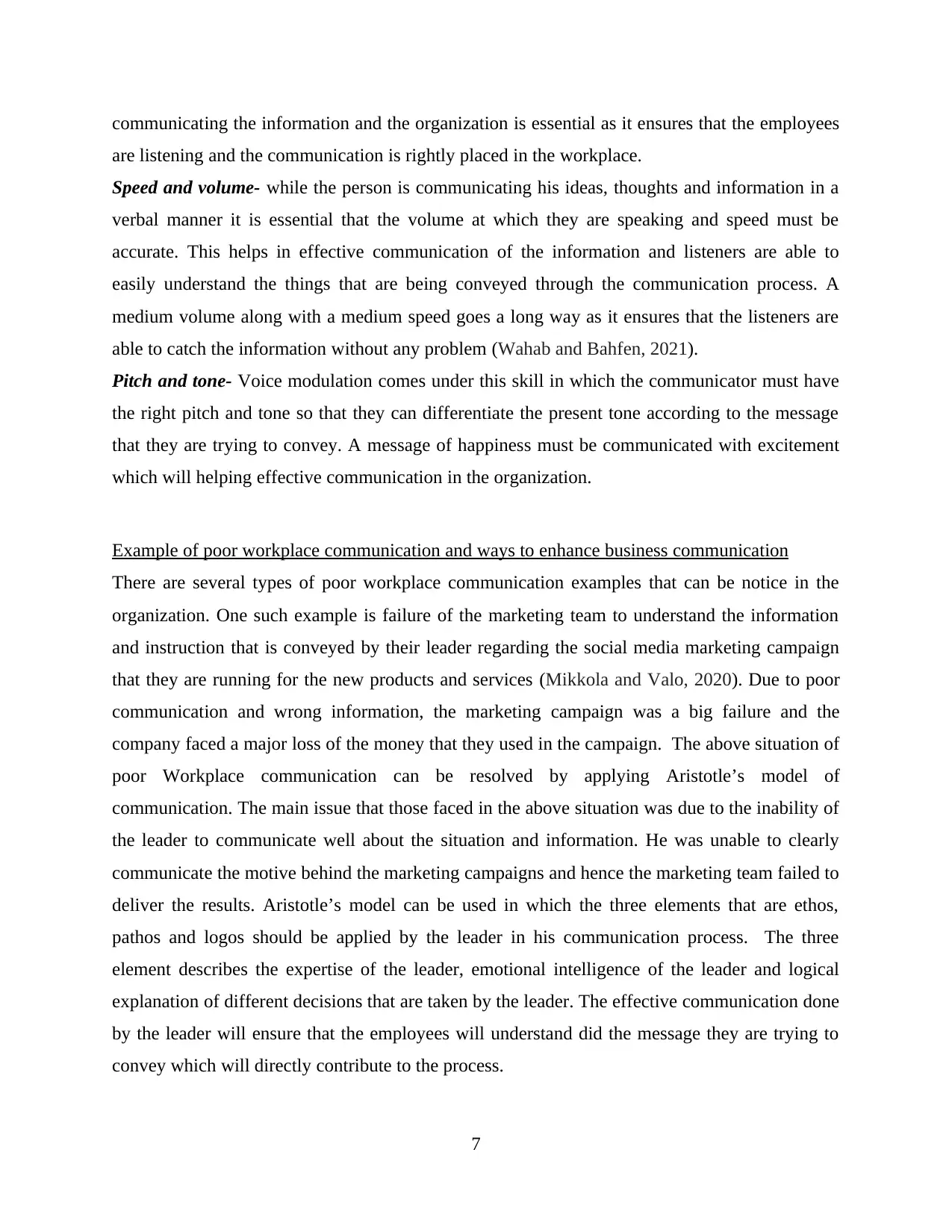
communicating the information and the organization is essential as it ensures that the employees
are listening and the communication is rightly placed in the workplace.
Speed and volume- while the person is communicating his ideas, thoughts and information in a
verbal manner it is essential that the volume at which they are speaking and speed must be
accurate. This helps in effective communication of the information and listeners are able to
easily understand the things that are being conveyed through the communication process. A
medium volume along with a medium speed goes a long way as it ensures that the listeners are
able to catch the information without any problem (Wahab and Bahfen, 2021).
Pitch and tone- Voice modulation comes under this skill in which the communicator must have
the right pitch and tone so that they can differentiate the present tone according to the message
that they are trying to convey. A message of happiness must be communicated with excitement
which will helping effective communication in the organization.
Example of poor workplace communication and ways to enhance business communication
There are several types of poor workplace communication examples that can be notice in the
organization. One such example is failure of the marketing team to understand the information
and instruction that is conveyed by their leader regarding the social media marketing campaign
that they are running for the new products and services (Mikkola and Valo, 2020). Due to poor
communication and wrong information, the marketing campaign was a big failure and the
company faced a major loss of the money that they used in the campaign. The above situation of
poor Workplace communication can be resolved by applying Aristotle’s model of
communication. The main issue that those faced in the above situation was due to the inability of
the leader to communicate well about the situation and information. He was unable to clearly
communicate the motive behind the marketing campaigns and hence the marketing team failed to
deliver the results. Aristotle’s model can be used in which the three elements that are ethos,
pathos and logos should be applied by the leader in his communication process. The three
element describes the expertise of the leader, emotional intelligence of the leader and logical
explanation of different decisions that are taken by the leader. The effective communication done
by the leader will ensure that the employees will understand did the message they are trying to
convey which will directly contribute to the process.
7
are listening and the communication is rightly placed in the workplace.
Speed and volume- while the person is communicating his ideas, thoughts and information in a
verbal manner it is essential that the volume at which they are speaking and speed must be
accurate. This helps in effective communication of the information and listeners are able to
easily understand the things that are being conveyed through the communication process. A
medium volume along with a medium speed goes a long way as it ensures that the listeners are
able to catch the information without any problem (Wahab and Bahfen, 2021).
Pitch and tone- Voice modulation comes under this skill in which the communicator must have
the right pitch and tone so that they can differentiate the present tone according to the message
that they are trying to convey. A message of happiness must be communicated with excitement
which will helping effective communication in the organization.
Example of poor workplace communication and ways to enhance business communication
There are several types of poor workplace communication examples that can be notice in the
organization. One such example is failure of the marketing team to understand the information
and instruction that is conveyed by their leader regarding the social media marketing campaign
that they are running for the new products and services (Mikkola and Valo, 2020). Due to poor
communication and wrong information, the marketing campaign was a big failure and the
company faced a major loss of the money that they used in the campaign. The above situation of
poor Workplace communication can be resolved by applying Aristotle’s model of
communication. The main issue that those faced in the above situation was due to the inability of
the leader to communicate well about the situation and information. He was unable to clearly
communicate the motive behind the marketing campaigns and hence the marketing team failed to
deliver the results. Aristotle’s model can be used in which the three elements that are ethos,
pathos and logos should be applied by the leader in his communication process. The three
element describes the expertise of the leader, emotional intelligence of the leader and logical
explanation of different decisions that are taken by the leader. The effective communication done
by the leader will ensure that the employees will understand did the message they are trying to
convey which will directly contribute to the process.
7
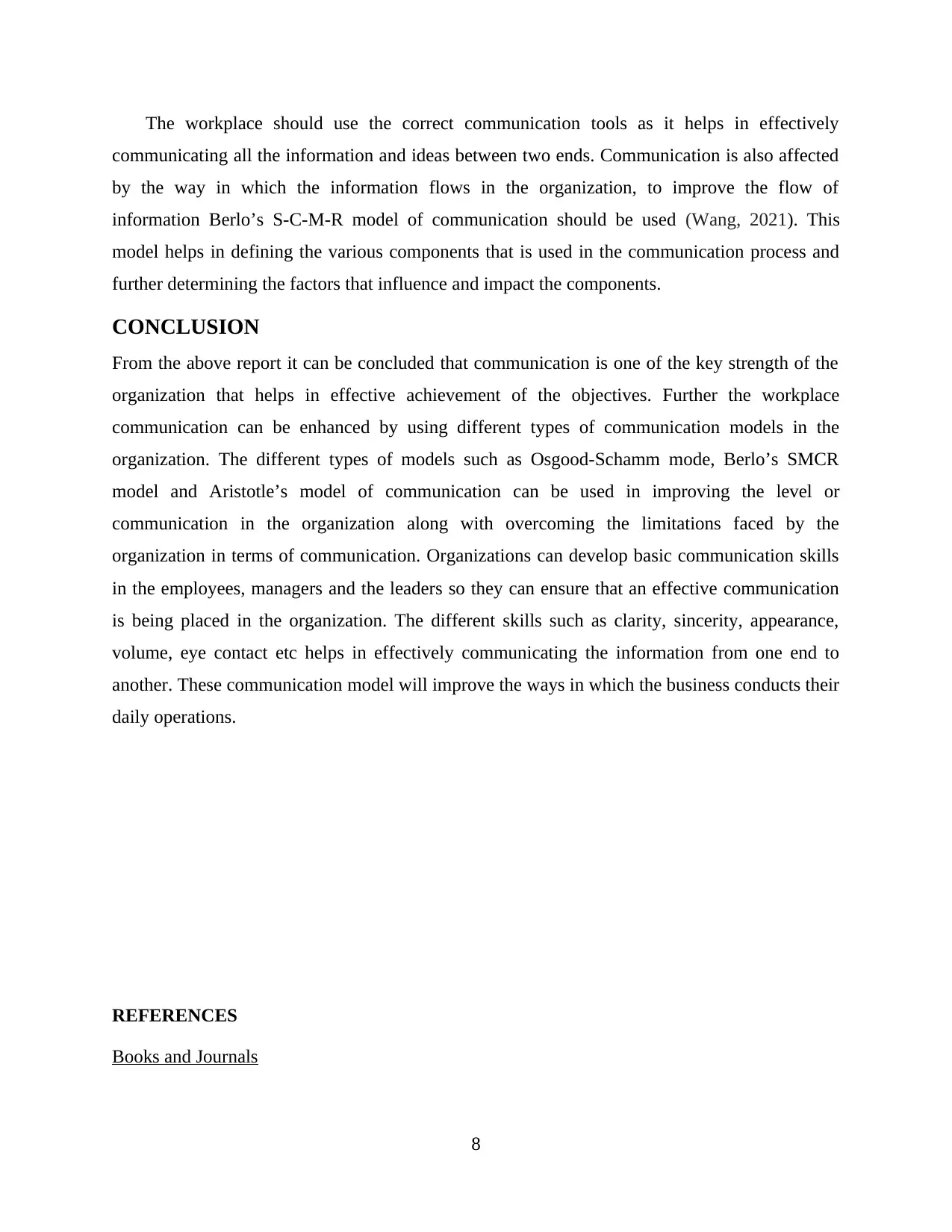
The workplace should use the correct communication tools as it helps in effectively
communicating all the information and ideas between two ends. Communication is also affected
by the way in which the information flows in the organization, to improve the flow of
information Berlo’s S-C-M-R model of communication should be used (Wang, 2021). This
model helps in defining the various components that is used in the communication process and
further determining the factors that influence and impact the components.
CONCLUSION
From the above report it can be concluded that communication is one of the key strength of the
organization that helps in effective achievement of the objectives. Further the workplace
communication can be enhanced by using different types of communication models in the
organization. The different types of models such as Osgood-Schamm mode, Berlo’s SMCR
model and Aristotle’s model of communication can be used in improving the level or
communication in the organization along with overcoming the limitations faced by the
organization in terms of communication. Organizations can develop basic communication skills
in the employees, managers and the leaders so they can ensure that an effective communication
is being placed in the organization. The different skills such as clarity, sincerity, appearance,
volume, eye contact etc helps in effectively communicating the information from one end to
another. These communication model will improve the ways in which the business conducts their
daily operations.
REFERENCES
Books and Journals
8
communicating all the information and ideas between two ends. Communication is also affected
by the way in which the information flows in the organization, to improve the flow of
information Berlo’s S-C-M-R model of communication should be used (Wang, 2021). This
model helps in defining the various components that is used in the communication process and
further determining the factors that influence and impact the components.
CONCLUSION
From the above report it can be concluded that communication is one of the key strength of the
organization that helps in effective achievement of the objectives. Further the workplace
communication can be enhanced by using different types of communication models in the
organization. The different types of models such as Osgood-Schamm mode, Berlo’s SMCR
model and Aristotle’s model of communication can be used in improving the level or
communication in the organization along with overcoming the limitations faced by the
organization in terms of communication. Organizations can develop basic communication skills
in the employees, managers and the leaders so they can ensure that an effective communication
is being placed in the organization. The different skills such as clarity, sincerity, appearance,
volume, eye contact etc helps in effectively communicating the information from one end to
another. These communication model will improve the ways in which the business conducts their
daily operations.
REFERENCES
Books and Journals
8
⊘ This is a preview!⊘
Do you want full access?
Subscribe today to unlock all pages.

Trusted by 1+ million students worldwide
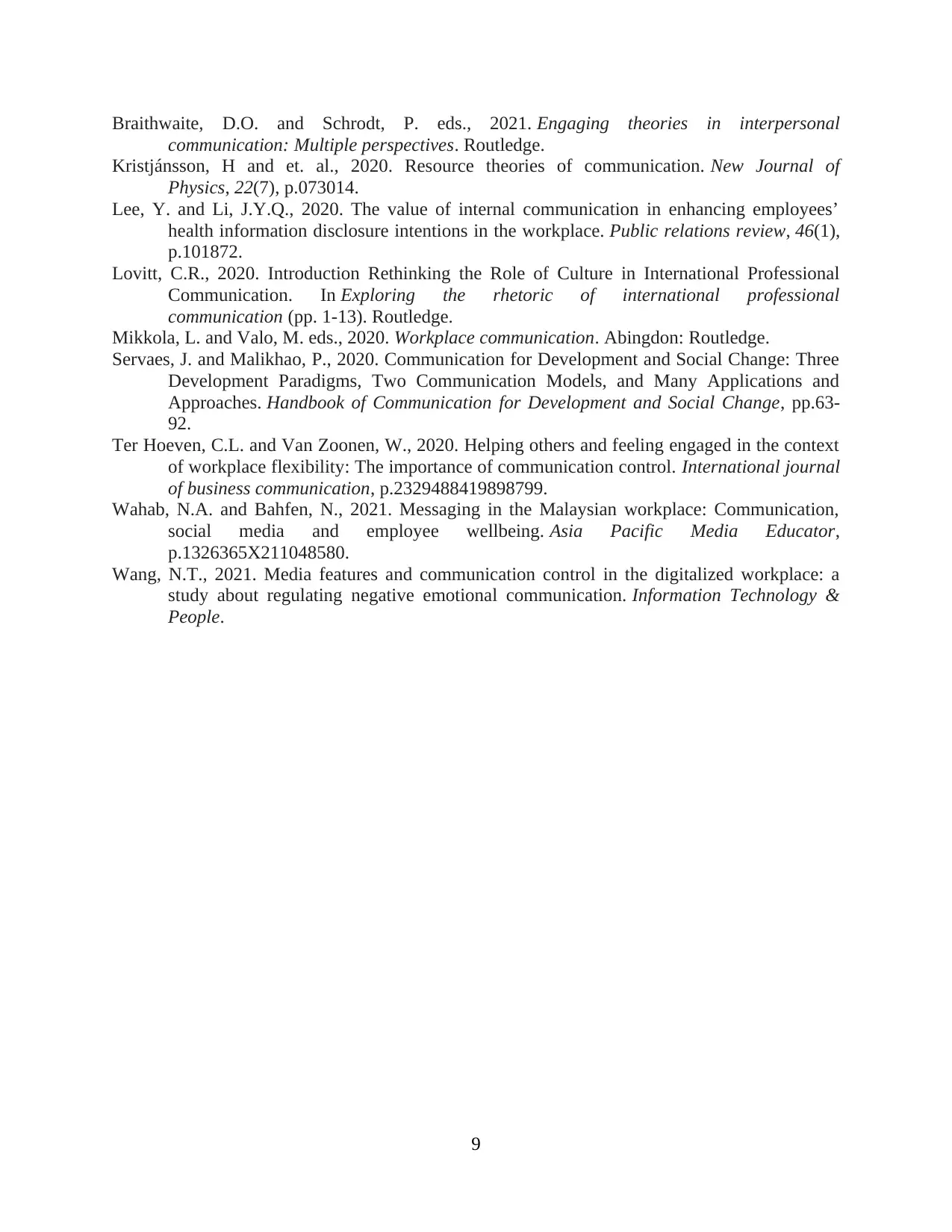
Braithwaite, D.O. and Schrodt, P. eds., 2021. Engaging theories in interpersonal
communication: Multiple perspectives. Routledge.
Kristjánsson, H and et. al., 2020. Resource theories of communication. New Journal of
Physics, 22(7), p.073014.
Lee, Y. and Li, J.Y.Q., 2020. The value of internal communication in enhancing employees’
health information disclosure intentions in the workplace. Public relations review, 46(1),
p.101872.
Lovitt, C.R., 2020. Introduction Rethinking the Role of Culture in International Professional
Communication. In Exploring the rhetoric of international professional
communication (pp. 1-13). Routledge.
Mikkola, L. and Valo, M. eds., 2020. Workplace communication. Abingdon: Routledge.
Servaes, J. and Malikhao, P., 2020. Communication for Development and Social Change: Three
Development Paradigms, Two Communication Models, and Many Applications and
Approaches. Handbook of Communication for Development and Social Change, pp.63-
92.
Ter Hoeven, C.L. and Van Zoonen, W., 2020. Helping others and feeling engaged in the context
of workplace flexibility: The importance of communication control. International journal
of business communication, p.2329488419898799.
Wahab, N.A. and Bahfen, N., 2021. Messaging in the Malaysian workplace: Communication,
social media and employee wellbeing. Asia Pacific Media Educator,
p.1326365X211048580.
Wang, N.T., 2021. Media features and communication control in the digitalized workplace: a
study about regulating negative emotional communication. Information Technology &
People.
9
communication: Multiple perspectives. Routledge.
Kristjánsson, H and et. al., 2020. Resource theories of communication. New Journal of
Physics, 22(7), p.073014.
Lee, Y. and Li, J.Y.Q., 2020. The value of internal communication in enhancing employees’
health information disclosure intentions in the workplace. Public relations review, 46(1),
p.101872.
Lovitt, C.R., 2020. Introduction Rethinking the Role of Culture in International Professional
Communication. In Exploring the rhetoric of international professional
communication (pp. 1-13). Routledge.
Mikkola, L. and Valo, M. eds., 2020. Workplace communication. Abingdon: Routledge.
Servaes, J. and Malikhao, P., 2020. Communication for Development and Social Change: Three
Development Paradigms, Two Communication Models, and Many Applications and
Approaches. Handbook of Communication for Development and Social Change, pp.63-
92.
Ter Hoeven, C.L. and Van Zoonen, W., 2020. Helping others and feeling engaged in the context
of workplace flexibility: The importance of communication control. International journal
of business communication, p.2329488419898799.
Wahab, N.A. and Bahfen, N., 2021. Messaging in the Malaysian workplace: Communication,
social media and employee wellbeing. Asia Pacific Media Educator,
p.1326365X211048580.
Wang, N.T., 2021. Media features and communication control in the digitalized workplace: a
study about regulating negative emotional communication. Information Technology &
People.
9
1 out of 10
Related Documents
Your All-in-One AI-Powered Toolkit for Academic Success.
+13062052269
info@desklib.com
Available 24*7 on WhatsApp / Email
![[object Object]](/_next/static/media/star-bottom.7253800d.svg)
Unlock your academic potential
Copyright © 2020–2025 A2Z Services. All Rights Reserved. Developed and managed by ZUCOL.



